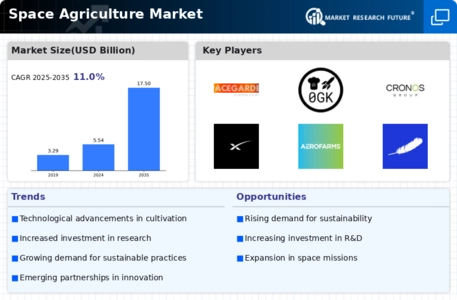Research and Development Initiatives
The Global Space Agriculture Market Industry is significantly influenced by ongoing research and development initiatives aimed at understanding plant biology in space. Institutions such as NASA and universities worldwide are conducting experiments to explore how microgravity affects plant growth and development. These studies are crucial for developing effective agricultural systems that can function in space. For instance, research on plant genetics and nutrient delivery systems is paving the way for more resilient crops that can thrive in harsh extraterrestrial conditions. The outcomes of these initiatives are expected to drive market growth, with projections indicating an increase from 5.54 USD Billion in 2024 to 17.5 USD Billion by 2035.
Increased Investment in Space Exploration
The Global Space Agriculture Market Industry is likely to benefit from increased investments in space exploration initiatives by both governmental and private sectors. Agencies such as NASA and ESA are allocating substantial budgets for missions aimed at establishing sustainable human presence on Mars and the Moon. For example, NASA's Artemis program aims to return humans to the Moon by 2025, necessitating the development of sustainable agricultural systems. This influx of funding is expected to drive research and development in space agriculture technologies, thereby expanding the market. The anticipated growth from 5.54 USD Billion in 2024 to 17.5 USD Billion by 2035 underscores the potential for innovation in this sector.
Growing Demand for Sustainable Food Sources
The Global Space Agriculture Market Industry is increasingly responding to the growing demand for sustainable food sources as Earth faces challenges such as climate change and population growth. Space agriculture presents a unique solution by enabling food production in environments where traditional agriculture is not feasible. The ability to grow food in space not only supports long-term missions but also has implications for food security on Earth. As the global population is projected to reach nearly 10 billion by 2050, the need for innovative agricultural solutions becomes more pressing. This trend is likely to contribute to the market's growth, with projections indicating an increase from 5.54 USD Billion in 2024 to 17.5 USD Billion by 2035.
Technological Advancements in Space Farming
The Global Space Agriculture Market Industry is experiencing rapid technological advancements that enhance crop production in extraterrestrial environments. Innovations such as hydroponics, aeroponics, and advanced LED lighting systems are being developed to optimize plant growth in space. For instance, NASA's Veggie experiment aboard the International Space Station has successfully grown various crops, demonstrating the feasibility of food production in microgravity. These technologies not only improve yield but also reduce resource consumption, making them essential for long-duration space missions. As a result, the market is projected to grow from 5.54 USD Billion in 2024 to 17.5 USD Billion by 2035, with a CAGR of 11.0% from 2025 to 2035.
Collaboration Between Space Agencies and Private Sector
The Global Space Agriculture Market Industry is witnessing a surge in collaboration between space agencies and private companies, which is fostering innovation and accelerating the development of agricultural technologies for space. Partnerships, such as those between NASA and private firms like SpaceX, are facilitating the transfer of knowledge and resources necessary for advancing space agriculture. These collaborations are essential for addressing the unique challenges posed by extraterrestrial farming, such as radiation exposure and limited resources. As these partnerships continue to evolve, they are expected to enhance the market's growth trajectory, contributing to an increase from 5.54 USD Billion in 2024 to 17.5 USD Billion by 2035.

















